Hailin Li
Towards Zero-Shot Differential Morphing Attack Detection with Multimodal Large Language Models
May 21, 2025Abstract:Leveraging the power of multimodal large language models (LLMs) offers a promising approach to enhancing the accuracy and interpretability of morphing attack detection (MAD), especially in real-world biometric applications. This work introduces the use of LLMs for differential morphing attack detection (D-MAD). To the best of our knowledge, this is the first study to employ multimodal LLMs to D-MAD using real biometric data. To effectively utilize these models, we design Chain-of-Thought (CoT)-based prompts to reduce failure-to-answer rates and enhance the reasoning behind decisions. Our contributions include: (1) the first application of multimodal LLMs for D-MAD using real data subjects, (2) CoT-based prompt engineering to improve response reliability and explainability, (3) comprehensive qualitative and quantitative benchmarking of LLM performance using data from 54 individuals captured in passport enrollment scenarios, and (4) comparative analysis of two multimodal LLMs: ChatGPT-4o and Gemini providing insights into their morphing attack detection accuracy and decision transparency. Experimental results show that ChatGPT-4o outperforms Gemini in detection accuracy, especially against GAN-based morphs, though both models struggle under challenging conditions. While Gemini offers more consistent explanations, ChatGPT-4o is more resilient but prone to a higher failure-to-answer rate.
Unsupervised Fingerphoto Presentation Attack Detection With Diffusion Models
Sep 27, 2024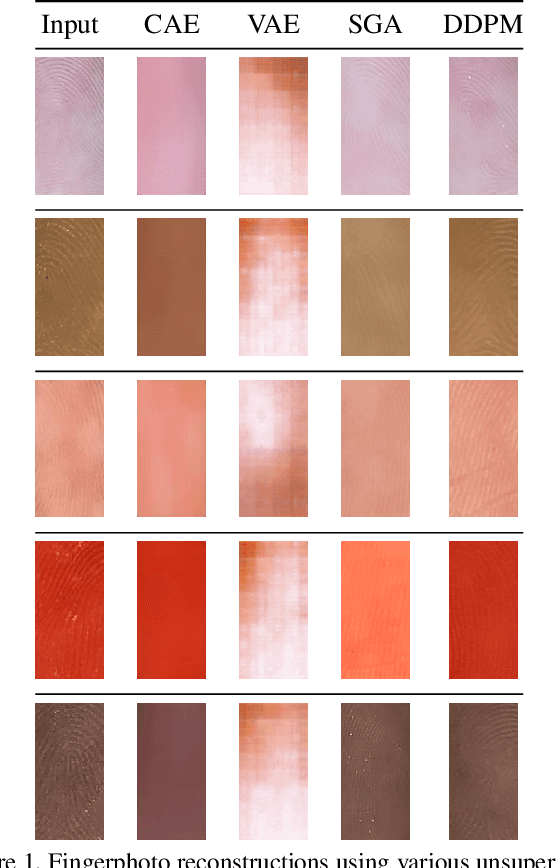
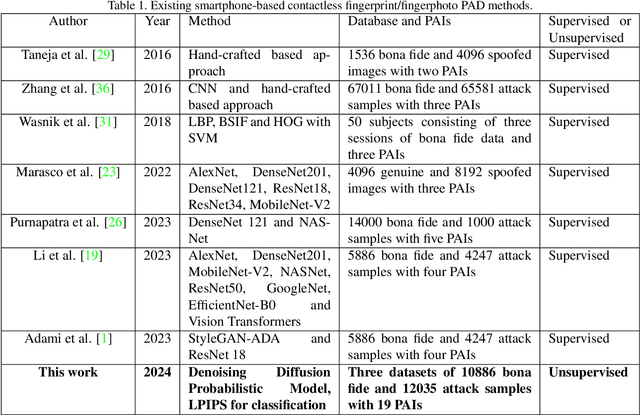
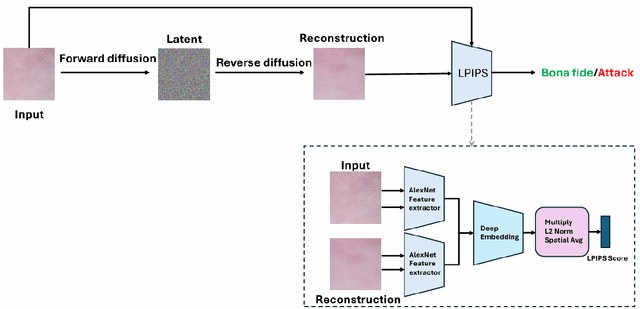
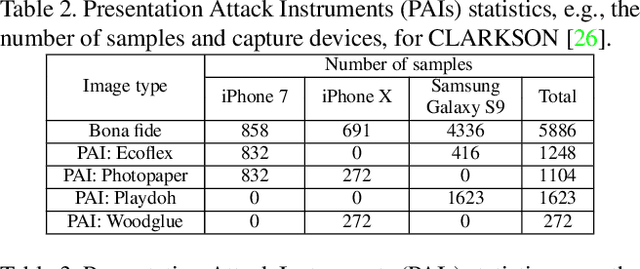
Abstract:Smartphone-based contactless fingerphoto authentication has become a reliable alternative to traditional contact-based fingerprint biometric systems owing to rapid advances in smartphone camera technology. Despite its convenience, fingerprint authentication through fingerphotos is more vulnerable to presentation attacks, which has motivated recent research efforts towards developing fingerphoto Presentation Attack Detection (PAD) techniques. However, prior PAD approaches utilized supervised learning methods that require labeled training data for both bona fide and attack samples. This can suffer from two key issues, namely (i) generalization:the detection of novel presentation attack instruments (PAIs) unseen in the training data, and (ii) scalability:the collection of a large dataset of attack samples using different PAIs. To address these challenges, we propose a novel unsupervised approach based on a state-of-the-art deep-learning-based diffusion model, the Denoising Diffusion Probabilistic Model (DDPM), which is trained solely on bona fide samples. The proposed approach detects Presentation Attacks (PA) by calculating the reconstruction similarity between the input and output pairs of the DDPM. We present extensive experiments across three PAI datasets to test the accuracy and generalization capability of our approach. The results show that the proposed DDPM-based PAD method achieves significantly better detection error rates on several PAI classes compared to other baseline unsupervised approaches.
Deep Features for Contactless Fingerprint Presentation Attack Detection: Can They Be Generalized?
Jul 04, 2023Abstract:The rapid evolution of high-end smartphones with advanced high-resolution cameras has resulted in contactless capture of fingerprint biometrics that are more reliable and suitable for verification. Similar to other biometric systems, contactless fingerprint-verification systems are vulnerable to presentation attacks. In this paper, we present a comparative study on the generalizability of seven different pre-trained Convolutional Neural Networks (CNN) and a Vision Transformer (ViT) to reliably detect presentation attacks. Extensive experiments were carried out on publicly available smartphone-based presentation attack datasets using four different Presentation Attack Instruments (PAI). The detection performance of the eighth deep feature technique was evaluated using the leave-one-out protocol to benchmark the generalization performance for unseen PAI. The obtained results indicated the best generalization performance with the ResNet50 CNN.
Deep Learning based Fingerprint Presentation Attack Detection: A Comprehensive Survey
May 27, 2023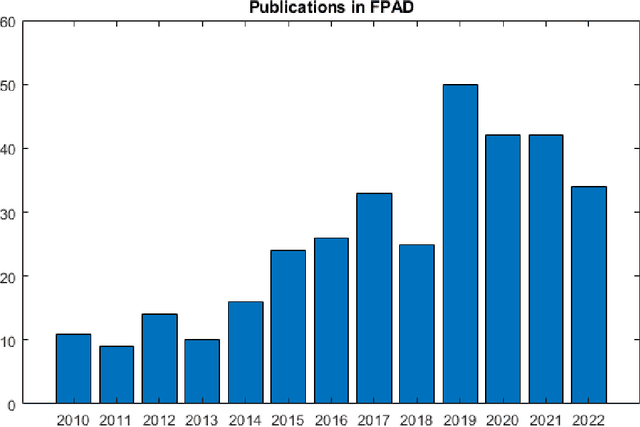
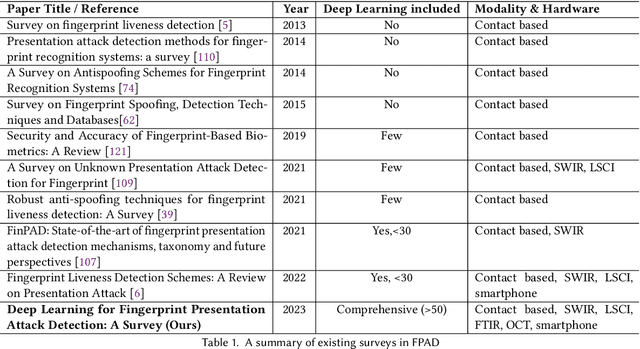

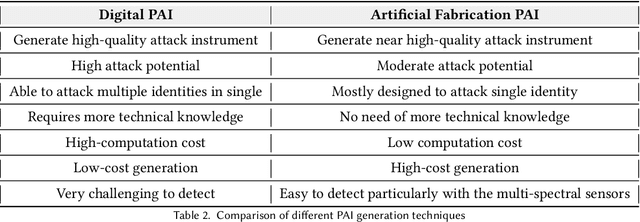
Abstract:The vulnerabilities of fingerprint authentication systems have raised security concerns when adapting them to highly secure access-control applications. Therefore, Fingerprint Presentation Attack Detection (FPAD) methods are essential for ensuring reliable fingerprint authentication. Owing to the lack of generation capacity of traditional handcrafted based approaches, deep learning-based FPAD has become mainstream and has achieved remarkable performance in the past decade. Existing reviews have focused more on hand-cratfed rather than deep learning-based methods, which are outdated. To stimulate future research, we will concentrate only on recent deep-learning-based FPAD methods. In this paper, we first briefly introduce the most common Presentation Attack Instruments (PAIs) and publicly available fingerprint Presentation Attack (PA) datasets. We then describe the existing deep-learning FPAD by categorizing them into contact, contactless, and smartphone-based approaches. Finally, we conclude the paper by discussing the open challenges at the current stage and emphasizing the potential future perspective.
Finger-NestNet: Interpretable Fingerphoto Verification on Smartphone using Deep Nested Residual Network
Dec 09, 2022
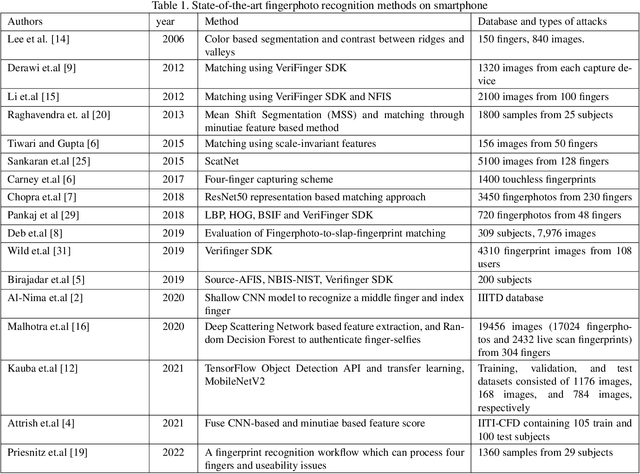
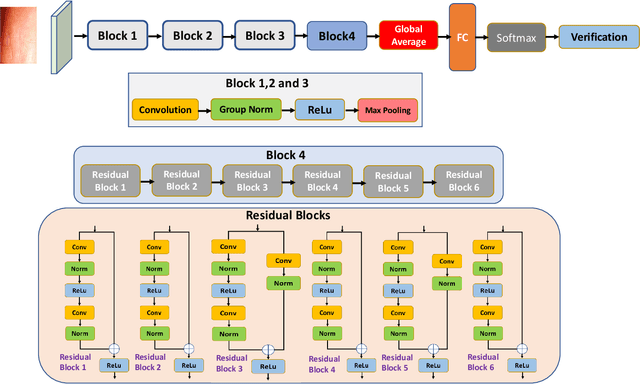
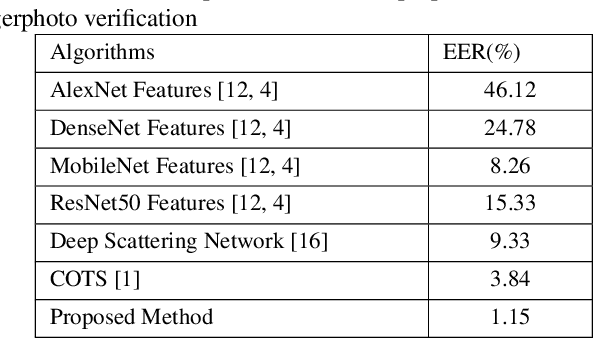
Abstract:Fingerphoto images captured using a smartphone are successfully used to verify the individuals that have enabled several applications. This work presents a novel algorithm for fingerphoto verification using a nested residual block: Finger-NestNet. The proposed Finger-NestNet architecture is designed with three consecutive convolution blocks followed by a series of nested residual blocks to achieve reliable fingerphoto verification. This paper also presents the interpretability of the proposed method using four different visualization techniques that can shed light on the critical regions in the fingerphoto biometrics that can contribute to the reliable verification performance of the proposed method. Extensive experiments are performed on the fingerphoto dataset comprised of 196 unique fingers collected from 52 unique data subjects using an iPhone6S. Experimental results indicate the improved verification of the proposed method compared to six different existing methods with EER = 1.15%.
Symmetric Dilated Convolution for Surgical Gesture Recognition
Jul 14, 2020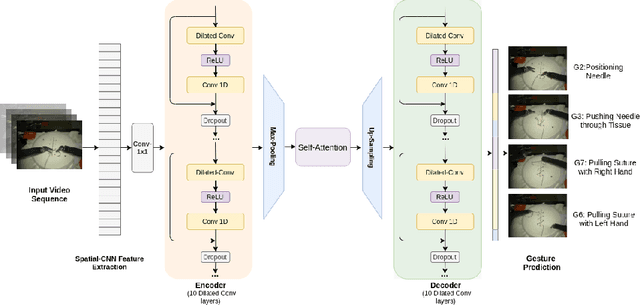

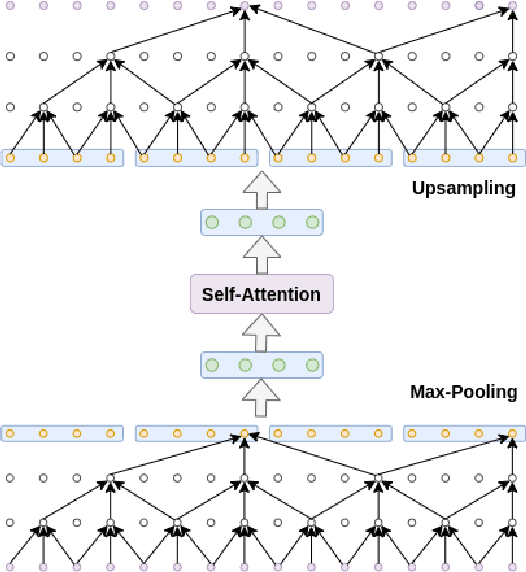

Abstract:Automatic surgical gesture recognition is a prerequisite of intra-operative computer assistance and objective surgical skill assessment. Prior works either require additional sensors to collect kinematics data or have limitations on capturing temporal information from long and untrimmed surgical videos. To tackle these challenges, we propose a novel temporal convolutional architecture to automatically detect and segment surgical gestures with corresponding boundaries only using RGB videos. We devise our method with a symmetric dilation structure bridged by a self-attention module to encode and decode the long-term temporal patterns and establish the frame-to-frame relationship accordingly. We validate the effectiveness of our approach on a fundamental robotic suturing task from the JIGSAWS dataset. The experiment results demonstrate the ability of our method on capturing long-term frame dependencies, which largely outperform the state-of-the-art methods on the frame-wise accuracy up to ~6 points and the F1@50 score ~6 points.
 Add to Chrome
Add to Chrome Add to Firefox
Add to Firefox Add to Edge
Add to Edge